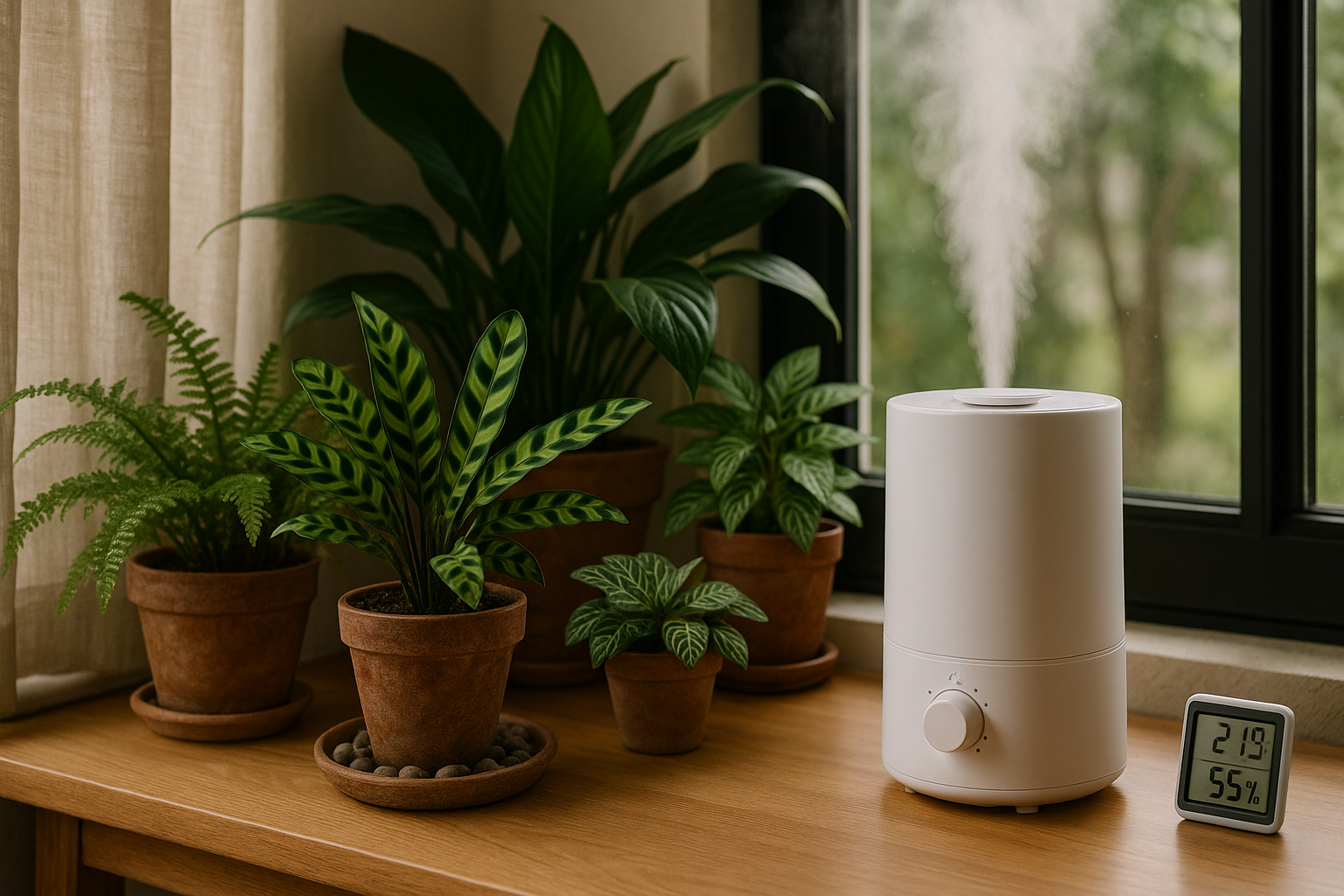Caring for indoor plants goes beyond watering and sunlight — humidity plays a crucial role in their health and growth. While it’s often overlooked, maintaining the right level of humidity can make the difference between a thriving, lush green plant and one with crispy leaves and stunted growth.
In this article, we’ll explore why humidity matters, how to measure and improve it, and practical, budget-friendly tips to create a plant-friendly environment in your apartment.
What Is Humidity and Why Does It Matter for Plants?
Humidity is the amount of water vapor present in the air. Most tropical and subtropical plants, which are popular choices for apartments, naturally grow in environments with high humidity levels — usually between 60% and 80%.
In contrast, most indoor environments — especially during colder months with heating systems — tend to have low humidity, often below 40%, which can lead to:
- Dry or crispy leaf edges
- Leaf drop or curling
- Brown tips or spots
- Slow or stunted growth
- Higher vulnerability to pests
Even if your watering routine is perfect, dry indoor air can slowly weaken your plants.
How to Know if Your Plants Need More Humidity
Some houseplants are more sensitive to dry air than others. Common signs that your plant is craving humidity include:
- Crispy or browning leaf edges, especially on ferns or calatheas
- Wilting despite proper watering
- Falling leaves or curled leaf tips
- Dry air feel in the room (your own dry skin or lips can be a clue, too)
Plants that typically require higher humidity:
- Ferns (e.g., Boston fern)
- Calatheas and Marantas
- Peace lilies
- Anthuriums
- Alocasias
- Orchids
- Fittonias (nerve plants)
If you have any of these, you’ll want to pay extra attention to air moisture.
How to Measure Humidity in Your Apartment
You don’t need to guess — a digital hygrometer can help you measure the exact humidity level in any room. They’re inexpensive and widely available online or in garden centers.
Ideal humidity levels for indoor plants:
- 40%–50%: Acceptable for most plants
- 50%–60%: Ideal for many tropical houseplants
- Above 60%: Best for humidity-loving species
Practical Tips to Raise Humidity for Your Indoor Plants
Let’s explore simple, effective, and affordable methods to increase humidity in your apartment:
1. Group Your Plants Together
Plants release moisture through transpiration. Placing several plants close to each other creates a microclimate with slightly higher humidity. This is especially effective on plant shelves or near windows.
2. Use a Humidifier
A small humidifier placed near your plants is the most consistent and effective solution. Run it for a few hours daily, especially during winter or in dry climates.
Tip: Choose an ultrasonic cool mist humidifier for better plant performance and quiet operation.
3. Place Plants on Pebble Trays
Fill a shallow tray with pebbles and water, then set your plant pot on top — just above the waterline. As the water evaporates, it creates localized humidity around the plant.
Important: Make sure the pot doesn’t sit directly in water to avoid root rot.
4. Mist Your Plants (Cautiously)
Misting with water can offer temporary relief for humidity-loving plants. However, it’s not a long-term solution, and frequent misting can lead to fungal problems if not done correctly.
Tips for safe misting:
- Mist in the morning
- Avoid misting plants with fuzzy or sensitive leaves
- Use clean, room-temperature water
5. Use the Bathroom Wisely
Many houseplants love humidity — and your bathroom is naturally humid after showers. If it has a window with some light, it can become the perfect spa-like plant zone for ferns, orchids, and calatheas.
What Not to Do When Dealing with Humidity
Some common mistakes can harm your plants rather than help:
- Don’t mist excessively — it doesn’t substitute for proper ambient humidity.
- Don’t close off airflow entirely — stagnant air invites mold and pests.
- Don’t place plants directly on heat sources (like radiators or heaters).
Maintaining humidity should support your plant’s health, not create new problems.
Advanced Tips for Enthusiasts
If you want to go a step further in creating the ideal environment:
– Use Room Zoning
Create plant zones with similar humidity needs. For example, group all tropicals in a corner near the humidifier and light source.
– Enclosed Terrariums
These are great for plants that love very high humidity, such as fittonias and mosses. A glass terrarium naturally holds in moisture.
– DIY Greenhouse Cabinet
Using a simple IKEA cabinet, added grow lights, and a small humidifier, many plant lovers create mini indoor greenhouses with controlled humidity and lighting — ideal for rare or demanding species.
Maintaining Balance: Humidity + Ventilation + Light
Remember: Humidity is just one part of the equation. Plants also need proper light, watering, and airflow. Don’t increase humidity at the expense of air circulation or light exposure.
- Open windows occasionally to refresh air
- Use a fan to keep air circulating
- Wipe leaves regularly to remove dust and allow efficient transpiration
Final Thoughts: A Healthy Plant Needs Healthy Air
Indoor plant care is not just about soil and water — it’s about the whole environment. Humidity plays a silent but vital role in plant health. With just a few adjustments, you can create a more comfortable microclimate in your apartment, not only for your plants but for yourself as well.
Whether you choose a humidifier, a pebble tray, or a leafy plant cluster, your efforts will be rewarded with vibrant foliage, fewer brown tips, and a happier indoor jungle.
